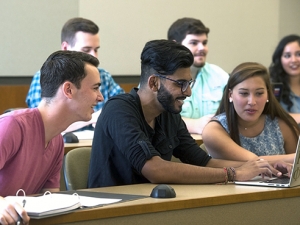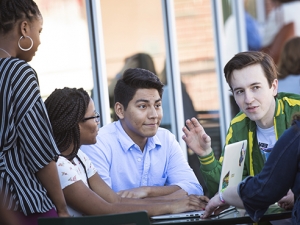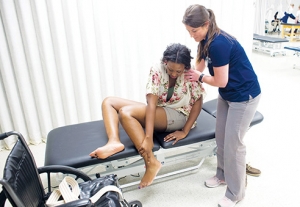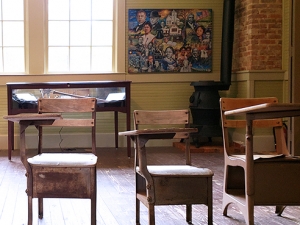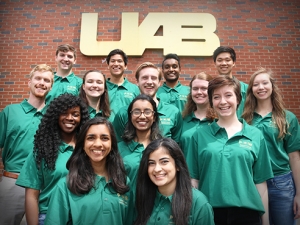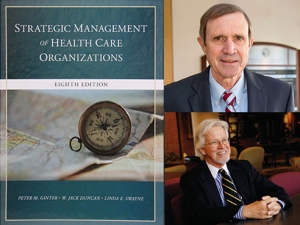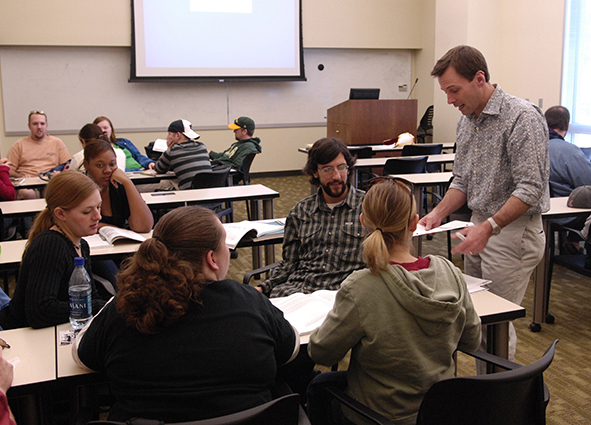 Andrew Keitt works with his students during a Reacting to the Past assignment. This fall, UAB will begin implementing its Quality Enhancement Plan (QEP) in schools and departments across campus. The new plan, which focuses on “learning in a team environment,” is designed to improve an aspect of student learning and enhance the quality of higher education as required by the Southern Association of Colleges and Schools Commission on Colleges.
Andrew Keitt works with his students during a Reacting to the Past assignment. This fall, UAB will begin implementing its Quality Enhancement Plan (QEP) in schools and departments across campus. The new plan, which focuses on “learning in a team environment,” is designed to improve an aspect of student learning and enhance the quality of higher education as required by the Southern Association of Colleges and Schools Commission on Colleges.
Peter Anderson, DVM, Ph.D., co-facilitator of the QEP steering committee, said it was clear from the beginning that a prescriptive QEP would not work for UAB.
“We have specifically tried to keep our QEP as non-prescriptive as possible in order to mesh well with our diverse university and student body,” Anderson said. “Our goal with the QEP is to provide educational resources and access to a variety of best practices that our faculty can use as models or templates for their specific application.”
The QEP will provide support for instructors who would like to use team-based approaches to teaching, but it will neither mandate a specific methodology nor require anyone to adopt one of them.
“We’re saying, ‘We want to make sure your students come out of here knowing how to talk to each other and work as a team,’ but we’re not going to tell you how you have to do that,” Anderson said. “We will try to provide you the resources that will allow you to do it the way that works best for you.”
Kristi Menear, Ph.D., co-facilitator of the QEP steering committee, said it was important to allow faculty to determine the best ways to implement the QEP in their curriculum because they know what will work best for their students.
“By being open-ended and facilitating the development of team-focused pedagogies in the appropriate settings we will allow faculty to use what works best for them and for their students in their own unique setting,” Menear said. “The types of pedagogies needed to enhance teamwork in a basic mathematics course is understandably different than the team dynamics in a simulated cardiac arrest scenario.”
There are many ways to incorporate team-learning into the classroom, including Team Based Learning™(TBL), flipped classroom and Reacting to the Past.
TBL is a popular method of small-group learning, which uses four components: permanent teams, readiness assurance, application activities and peer evaluation. Students read materials before class, take an individual readiness assessment test, work in groups on activities during class, participate in discussion and take a team-readiness assessment together. Students also complete one or more peer evaluations during the semester.
In a flipped classroom, students either read material or watch a lecture before class and do practical work during class in teams with the guidance of the professor.
According to the Barnard College Reacting to the Past website, “Reacting to the Past (RTTP) consists of elaborate games, set in the past, in which students are assigned roles informed by classic texts in the history of ideas. Class sessions are run entirely by students; instructors advise and guide students and grade their oral and written work. It seeks to draw students into the past, promote engagement with big ideas, and improve intellectual and academic skills.”
‘New level’ of understanding
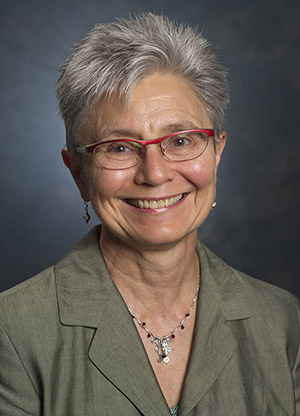 Diane TuckerDiane Tucker, Ph.D., professor of psychology, is no stranger to team-learning techniques; she’s used some form of team-learning in her classroom for the past nine years.
Diane TuckerDiane Tucker, Ph.D., professor of psychology, is no stranger to team-learning techniques; she’s used some form of team-learning in her classroom for the past nine years.
She used a modified version of TBL in a statistics class beginning spring 2014. She had students take an individual and then team-based readiness assessments, which helped students understand the material better than just listening to her lecture. She also has used other forms of team-learning.
“The thing that I’ve been doing for a while is termed collaborative learning,” Tucker said. “Small groups of usually three students work together on a semester-long project that has multiple phases.”
Tucker said she builds in an interdisciplinary element with the groups by choosing students with different majors and by having both genders represented.
“What I have found is that when a team is engaged, the students are much more likely to ask each other questions and push the understanding to a new level,” Tucker said. “They’re also more willing to ask questions of the instructor or argue their points because it’s not just their individual idea, it’s been corroborated by their team members.”
“The first time you implement a team-learning method in your classes it can require more preparation,” Tucker said. “But I really enjoy the dynamic nature of a collaborative learning environment because I find that I have to be very nimble and ready to answer questions that require creativity and thinking on my feet. I enjoy that interactive feeling that I’m communicating with the students and that I’m responding to what they need to know.”
One benefit to using assessments, Tucker said, is that she knows exactly what she needs to revisit and clarify.
“I don’t need to waste time on things that everyone in the group has pretty much figured out,” Tucker said. “I can see where the disconnect is and then give much more targeted input.”
In order to make every member of the team more accountable, Tucker has students give peer evaluations at the end of the semester. Although, Tucker said, she may begin requiring peer evaluations at mid-semester also. As an added layer of accountability, Tucker said, she has upper-level undergraduate students assisting with classes, and they keep an eye out for those not pulling their weight.
“We tend to know if there isn’t adequate contribution from everyone on the team,” Tucker said. “We deal with that directly by calling in the student or the team and intervening.”
Students in Tucker’s classes also are required to do individual work before class — where they combine their work during a team assignment.
“If you don’t have each student individually engaged in the material first, then you do end up with people who freeload,” Tucker said. “We help alleviate that concern by ensuring that everyone brings their individual work to class.”
‘Active learning’
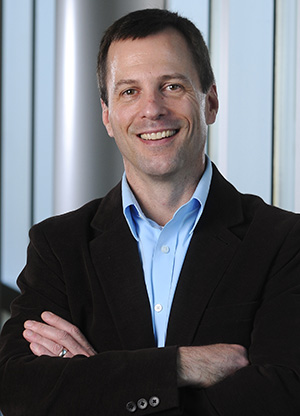 Andrew KeittAndrew Keitt, Ph.D., associate professor of history, said he wasn’t interested in team-based education when he began implementing Reacting to the Past to his classes in 2007.
Andrew KeittAndrew Keitt, Ph.D., associate professor of history, said he wasn’t interested in team-based education when he began implementing Reacting to the Past to his classes in 2007.
“I was really just interested in deep or active learning, and, if you want to do that, you have to create a classroom environment where you have discussion and students are defending their positions,” Keitt said.
About five years ago, Keitt incorporated TBL into his classroom, and he actively promotes it to his colleagues.
“It’s a way to produce the kind of outcomes we all want, such as critical thinking and deep, engaged learning,” Keitt said. “I want to encourage higher-level thinking in my classes. Unless students have to actively participate, defend their ideas and solve problems, the default position is passive learning of what the professor is telling them.”
Keitt said there’s a steep learning curve with implementing Team Based Learning into the classroom, but you end up with a planning structure you can use from semester to semester. He said the biggest change was more students asking questions and fewer students surfing Facebook.
Ken Gunnells, Ph.D., instructor in the department of Management, Information Systems and Quantitative Methods, also uses TBL is in his classroom. Gunnells said he stumbled upon TBL during a training session in 2013.
He said he likes TBL because the process prepares students to come to class ready to apply the book’s lessons to real-world cases and settings.
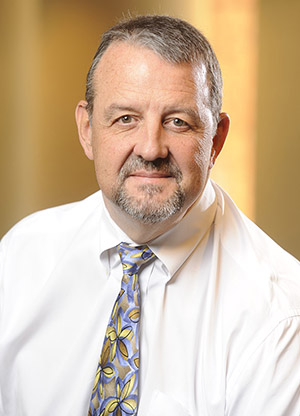 Ken Gunnells“It’s also great because students begin to learn from each other instead of relying on me as the sole source of information,” Gunnells said. “It also teaches them how to work in a team, and the social aspects of teams is a great force to induce poorer students to do better.”
Ken Gunnells“It’s also great because students begin to learn from each other instead of relying on me as the sole source of information,” Gunnells said. “It also teaches them how to work in a team, and the social aspects of teams is a great force to induce poorer students to do better.”
A critical component to TBL, Gunnells said, is the peer evaluations.
“When peer pressure fails to induce poorer students to do the required work, peer evaluation can punish bad team behavior or reward hard work gradewise,” Gunnells said. “Done right it can also provide valuable knowledge about how others see one’s behavior, so that corrections can be made.”
All three say it requires additional work to incorporate team-learning techniques into the classroom, but the rewards are worth it.
“It’s just so much fun to teach this way, because it becomes much more of a conversation and much more dynamic,” Tucker said. “I think we need to realize as faculty that we have the expertise that allows us to think on the fly and do this more dynamic teaching. That can seem intimidating, but I have found it to be much more enjoyable.”
Assessing team learning
Although the QEP is not prescriptive, outcomes will be evaluated using the assessment component being developed by Scott Snyder, Ph.D., associate professor of Human Studies and director of the Center for Educational Accountability, and a team from the center.
Related stories:UAB gearing up for campuswide emphasis on team learningStudents use teamwork to promote QEP Students earn real-world experience without real-life consequences |
“To ensure we are getting the outcomes we are looking for we must use our well-designed assessment program to be able to track our successes — which we will try to duplicate — and our failures, which we hope to prevent or at least minimize,” Anderson said.
Menear said rubrics, surveys and focus groups will assess basic components of team-learning techniques across the curriculum.
“So, a student taking a theater course will be exposed to team learning and be evaluated on team pedagogies just as biology major will be assessed while doing team-learning projects in an advanced biology laboratory course,” Menear said. “The basics of succeeding in all roles of a team can be assessed and tracked throughout the continuum of specific subjects or situation in which the team learning takes place.”
The QEP will not affect only the classroom, but it will be implemented through co-curricular units across campus during the five-year plan. Menear said learning in a team environment takes place all day, from residence halls to intramural fields.

